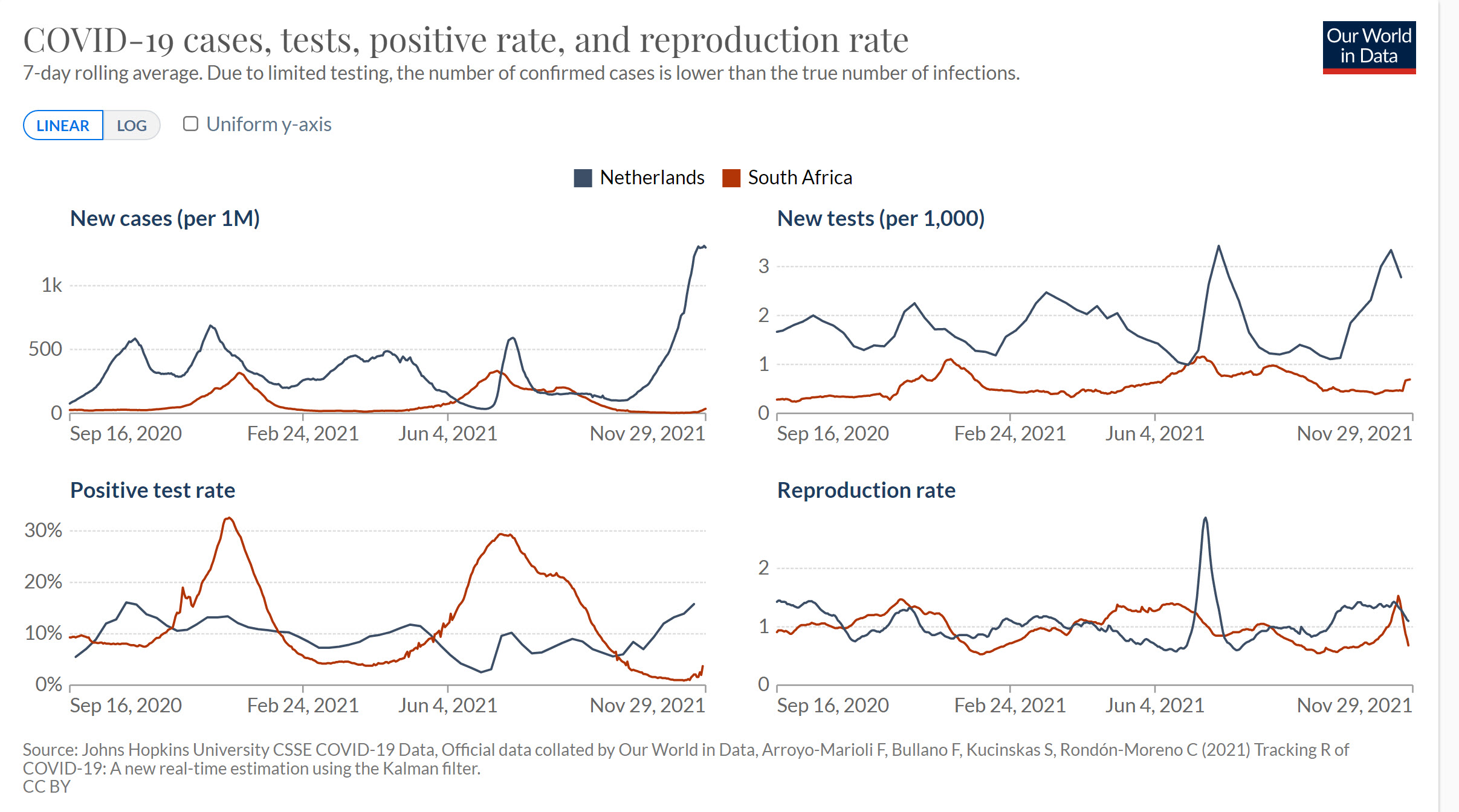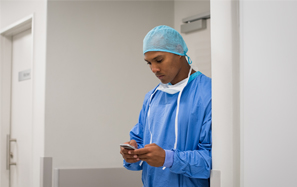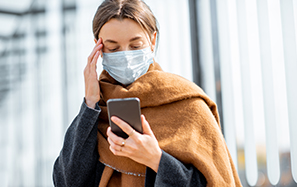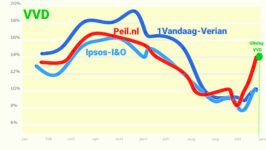There are strong indications that a lot went wrong on Friday, including with the execution of the PCR tests by GGD-Kennemerland (the municipal health service). Those 61 positive tests make for an extremely unlikely number. Among others, that Spanish "refugee" tested negative on Monday as well as another passenger.
Lees volledig artikel: Major questions surrounding the 2 South African flights
Additional info
After the publication of the article yesterday about the events surrounding the two flights from South Africa, which landed at Schiphol on Friday and in which 10% of the passengers had tested positive, I received some interesting additional information.
My main conclusion is that the virus (old and new variants) apparently affects one’s logical thinking ability. When viewed from a perspective of fear, it doesn’t matter how real the facts are. If something fits the narrative, then everyone (including most media) assumes it is the case.
I have spoken to people who were on the flight, read interviews with those involved (including the Spanish couple who are said to have “fled”) and had a conversation with a Dutchman in Pretoria, close to the source (that’s where the new “Omicron” variant was first discovered). And the picture that emerges from all this is that a lot more went wrong around those planes on Friday than what people think they know now.
First, a few facts/estimations in a row:
- A number of responses stated that all people on the flight, vaccinated or unvaccinated, should have been tested beforehand. That was absolutely not the case. However, if vaccinated persons had flown from outside South Africa to Johannesburg in order to continue to the Netherlands, they had to have a PCR test. However, the share of that group on the two flights was small.
- Although the vaccination rate in South Africa is still around 25%, it is estimated that a large majority of South Africans who were on the flight had been vaccinated. Not to mention the Dutch people on board and those who flew on from Schiphol to another country (somewhere in Europe or the US). This estimation has to do with the aspect of “prosperity”. Those who are wealthy enough to travel from South Africa to Europe, belong to the group of South Africans who have a high vaccination rate. My contact in South Africa has even been vaccinated for the third time. It is estimated that the share of vaccinated people on the flight was around 70%.
- The passengers of the two planes were kept separated (on the G and E piers). The sanitary conditions were abominable. At one point, we even ran out of toilet paper.
- The head of communications of GGD-Kennemerland first showed her face to the passengers around midnight.
- This is an interview with a New York Times reporter who was on board one of those planes and thought she had landed in a third world country.
The numbers can’t be right
If you know the figures for South Africa and hold that against the outcome that 10% of the passengers tested positive (while an estimated 30% had a PCR test or rapid test prior to the flight) then something absurd is going on. Let me explain:
Let’s pretend that these flights came from the Netherlands and had flown to South Africa. And that they had used the same method for checking in as was used for these flights. Plus, let’s pretend that 70% were vaccinated and didn’t need to get tested and 30% did get tested. And then let’s do the math on how many of the passengers in South Africa would then be tested positive by the health authorities there if everyone on the flight had taken a PCR test:
So,
- In the Netherlands, access tests are now around 1.5% positive. That seems to be a good representation of the situation in the Netherlands as a whole. But let’s make it 2% for convenience.
- And let’s also assume that none of those who are positive have symptoms. (I make these assumptions to make the outcome for this Dutch flight as unfavorable as possible).
- There are 600 passengers on the flight. 180 had to be tested. Of these, 2% were positive. Let’s say 4 passengers. And because the test is not 100% reliable, 1 passenger slipped through with a negative result, which should have been positive. So out of these 180 people, there is 1 on the flight that is positive.
- Among the remaining 420 vaccinated passengers, 2% are positive. That makes 8.
- In short, if we err on the side of caution once more, let’s say there are 10 “infected” passengers on this flight from the Netherlands to South Africa. If all passengers were to then get a proper PCR test after arrival in South Africa, the result would be that 10 passengers (1.7%) were positive.
The other way around
This is the calculation for a flight from the Netherlands to South Africa. But what would the numbers look like if it were the other way around?
Our World in Data allows us to compare figures from the Netherlands and South Africa.

Something peculiar is going on
The current figures in South Africa are clearly more favorable than in the Netherlands: among other things, there are far fewer positive cases, and a much lower percentage of positive test results. But there is less testing, so let’s pretend for the sake of convenience that the situation in South Africa is the same as in the Netherlands.
If the situation in South Africa is the same as in the Netherlands in terms of infection rate, then 10 people from those two planes should have gotten a positive test result, not 61.
But in reality, GGD-Kennemerland tested 61 people positive.
Clearly, something very peculiar is going on. I can only think of three explanations:
- As consolation for being infected as a vaccinated person in South Africa, 50 people were offered a free trip to the Netherlands by the local health service as compensation. And that group of 50 was in one of those planes.
- The twist of fate was such that something with the odds of 1 in 100 million happened last Friday.
- A large part of the positive tests at the GGD-Kennemerland last Friday were not really positive (what that means for those Omicron figures, I’ll leave aside for now).
Incorrect test results
I assume you can read between the lines that I think the latter was the case. When I see the chaos that occurred at Schiphol and at the GGD, it is easy to imagine that something went horribly wrong in the overall process from testing to obtaining the results, resulting in figures (10% positive, almost a quarter of which with the Omicron variant) that are highly unlikely.
And there are a few more pieces of information that suggest this may be the case:
- Kim, who was interviewed by De Volkskrant and was supposedly tested positive, later received a letter of apology. The result turned out to be a mistake.
- The Spanish couple who “had fled” reported on their experiences in several places. This is their interview in a Catalan newspaper. Via Google Translate, it can also be translated from Catalan. So she tested positive on Friday. But she had also taken a PCR test before the flight, which had a negative result! The Catalan newspaper reports that she did have Corona three months ago. They had asked to repeat the PCR test at the hotel on Saturday, but this was refused. When they then took two rapid tests themselves, the results were negative. In the interview with RTL-Nieuws, they then explain what happened. The icing on the cake is the PCR test, which was taken yesterday in the hospital in Haren, where they are now stuck: again, negative.
- And another passenger repeated his PCR-test tuesday with the GGD and the result was negative.
Recap
So allow me recap the situation with the Spanish “fugitive”. She had
- Corona three months ago,
- a negative PCR test result before departure in South Africa,
- then a positive PCR test result with the GGD on Friday,
- a rapid test came back negative during the weekend,
- and on Monday in Haren, a PCR test with a negative result……
A negative PCR test result before departure in South Africa. And a positive PCR test result with the GGD on Friday. A rapid test came back negative during the weekend. And on Monday in Haren, a PCR test with a negative result……
Also realize that the GGD in the Netherlands now says that you should take into account that you can still test positive up to 4 weeks after your positive PCR test. (I was told this myself by BCO two weeks ago. After a week with little symptoms, my rapid test was negative again.)
- Another passenger had a negative result with his PCR-test at the GGD last tuesday, while he was also positive after arriving at Schiphol.
- In addition, I have been in contact with someone else who was tested positive by the GGD on Friday. They took a rapid test this weekend and it came back negative.
So just the fact that the number of 61 people tested positive must have been extremely unlikely and some anecdotes showing how much has already gone wrong, should be more than enough for an INDEPENDENT investigation into what happened on Friday. Especially with regard to the quality of the PCR tests performed by the GGD. (With what CT value and did something go very wrong in handling the tests performed under high pressure?)
Taken for a fool
If there is no strong pressure for this INDEPENDENT investigation, neither from politics nor from the media, then we must come to the conclusion that, with all we are dealing with, we as citizens are simply being taken for a fool. As long as it meets the intended narrative, everything is permissible.
The fact that this New York Times journalist experienced first hand on Friday how poorly we have organized things in the Netherlands should make us face the facts. But most people in the Netherlands don’t seem to be interested in that. For whatever reason, people prefer to go along with the prevailing narrative, and after more than 18 months it is apparently impossible or undesirable to break away from it.







